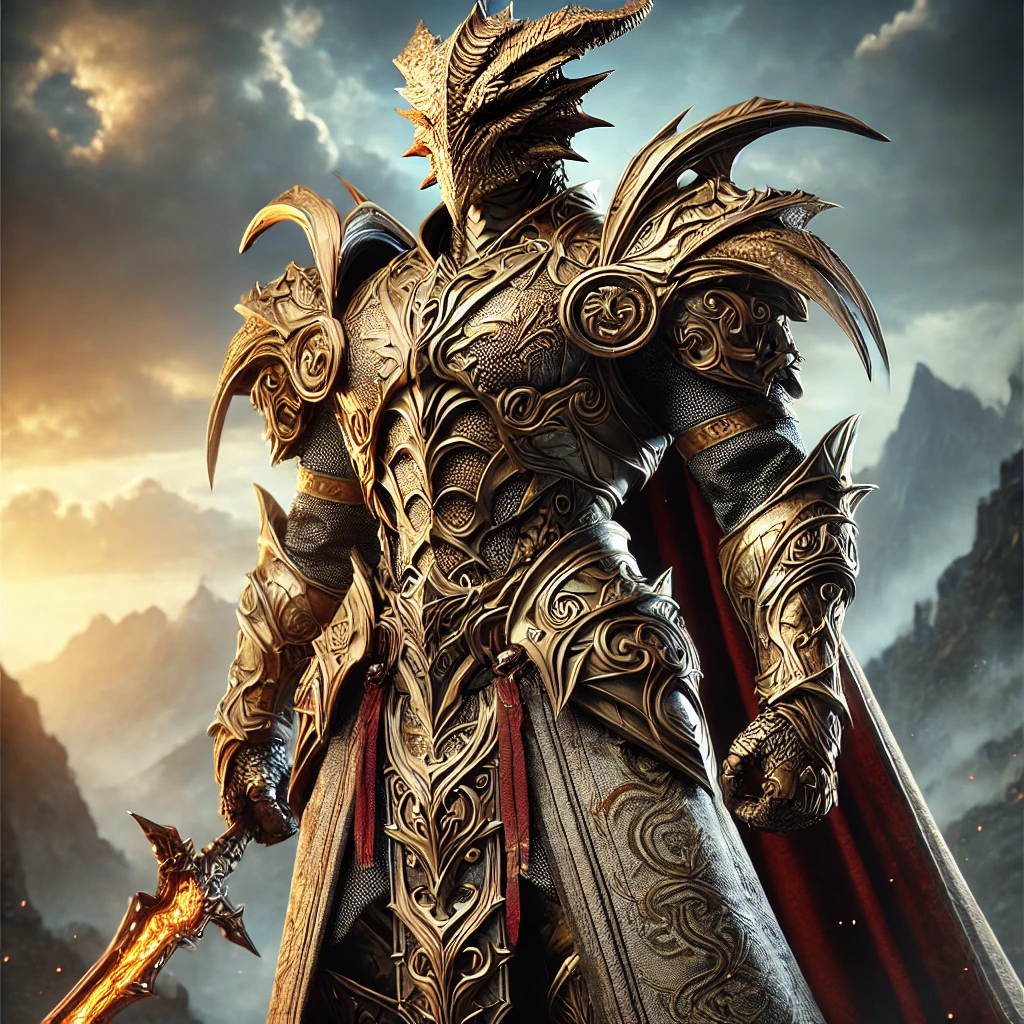Dragonborn
The Dragonborn are a proud and enigmatic race, their history intertwined with the legacy of the draconic gods and marked by rebellion. Bearing the unmistakable traits of their draconic ancestry, they are a people of strength and defiance, carving out their place in the world while forging a new path independent of their creators.
Appearance and Traits
Dragonborn are a striking race, their draconic heritage evident in every facet of their appearance. Their scales shimmer with hues reminiscent of the great dragons- Metallic golds and silvers, deep Chromatic reds, blues, and greens—each hue a reflection of their ancestry.
Height and Build: Standing between 6 and 8 feet tall, Dragonborn are powerfully built, with muscular frames that speak to their innate resilience.
Eyes and Features: Their reptilian eyes gleam with intelligence, and their heads often bear frills, horns, or crests that hint at their draconic lineage.
Breath Weapon: Each Dragonborn carries the power of a breath weapon, an elemental burst tied to their ancestry, such as fire, lightning, or poison.
Origins: Chains of the Past
The Dragonborn were created by the draconic gods, Bahamut and Tiamat , to serve as their emissaries, warriors, and champions. While Bahamut imbued his creations with a sense of nobility and valor, Tiamat instilled cunning and ambition. Yet, both demanded absolute loyalty and obedience, treating the Dragonborn as pawns in their divine struggles.
Over time, this servitude sowed resentment among the Dragonborn. Rebellion erupted in what became known as the Draconic Schism , a bloody conflict where the Dragonborn fought to sever their bonds to their creators. Though they paid a great price in lives and suffering, the Dragonborn ultimately won their freedom, scattering across the world to forge their own destinies.
Today, most Dragonborn view the gods with distrust at best and hatred at worst. To many, the draconic gods are symbols of their ancestors’ chains, and worshiping them is seen as an affront to the sacrifices made during the Schism.
Culture and Society
Dragonborn culture is shaped by their history of servitude and rebellion, fostering fierce independence and a strong disdain for gods and those who worship them. However, exceptions exist among their kind, creating tension within their communities.
General Distrust of Gods: Most Dragonborn reject the worship of deities altogether, viewing it as a submission to forces that once sought to dominate them. To them, freedom is sacred, and placing faith in any higher power is seen as a betrayal of their ancestors' struggle.
Followers of Bahamut and Tiamat: Despite this cultural norm, a minority of Dragonborn still revere their creators. Worshipers of Bahamut honor ideals of justice and protection, while those devoted to Tiamat embrace ambition and power. While tolerated in most communities, these individuals are often viewed with suspicion and mistrust.
Clan Structure: Dragonborn society revolves around clans, which serve as their primary source of identity and support. Clans are less about bloodlines and more about shared values and goals, creating a bond stronger than family ties.
Rites and Traditions
Dragonborn life is marked by traditions that emphasize strength, individuality, and remembrance of their struggle for freedom. These rituals often celebrate their draconic ancestry while rejecting subjugation.
1.the Rite of Scales : A coming-of-age ceremony where young Dragonborn display their breath weapon for the first time, symbolizing their personal strength and contribution to the clan.
2. The Day of Ashes : A solemn day of remembrance for those who perished during the Draconic Schism, marked by storytelling and moments of silent reflection.
3. Trial of the Flame : A ceremonial challenge where Dragonborn face physical and mental trials to prove their worth, often undertaken before becoming clan leaders or warriors.
Relations with Other Races
The Dragonborn’s history of rebellion shapes their interactions with others. They respect strength and independence but are wary of those who impose authority or show devotion to deities.
Humans and Elves : Uneasy alliances are common, as Dragonborn respect their adaptability but distrust their hierarchical and often religious societies.
Dwarves : Dragonborn admire the dwarves’ craftsmanship and resilience but often clash over the dwarves’ reverence for gods like Moradin.
Orcs and Goblins : Relations are generally hostile, with frequent clashes over territory and resources. Dragonborn see these races as chaotic and unreliable.
Dragonborn in Magic and Combat
Dragonborn excel in roles that allow them to wield their physical and elemental strength without being bound by traditional expectations. Their heritage lends itself to a variety of pursuits:
Warriors and Paladins: Dragonborn warriors are fearsome in battle, using their breath weapon and physical might to dominate the battlefield. Paladins among the Dragonborn, often followers of Bahamut, are rare but highly respected.
Sorcerers: Many Dragonborn are naturally attuned to magic, often manifesting sorcerous powers tied to their draconic ancestry.
Rogues and Outcasts: Some Dragonborn embrace lives of solitude or mercenary work, rejecting societal roles to carve their own paths.
Legacy of the Dragonborn
The Dragonborn stand as a living testament to resilience and defiance. They bear the strength and power of their draconic heritage while rejecting the chains of their past. Their culture, rooted in independence and self-reliance, serves as a beacon for their future, ensuring they will never bow again.
While Bahamut and Tiamat still inspire some Dragonborn, the majority view them as relics of a bygone era. The Dragonborn strive to shape their destinies with their own strength, forging a legacy that honors their ancestors’ sacrifices and celebrates the freedom they hold dear.
Origin/Ancestry
Draconic
Lifespan
70-90
Average Height
6-8 feet
Related Organizations



Comments